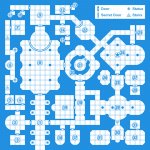Kris
Adventurer
After receiving a couple of requests on how to draw old-school dungeon maps (like the one pictured below) I thought I would try my hand at writing a quick tutorial with the aim of doing just that.
Anyway, I think I might have made it sound way more complicated than it actually is, but if anyone's interested in giving it a try, here's a link to each part of the tutorial:
Part 1
Part 2
Part 3
(note that for this tutorial I have only used freely available software - so anyone can give it a try)

Anyway, I think I might have made it sound way more complicated than it actually is, but if anyone's interested in giving it a try, here's a link to each part of the tutorial:
Part 1
Part 2
Part 3
(note that for this tutorial I have only used freely available software - so anyone can give it a try)

Last edited:
